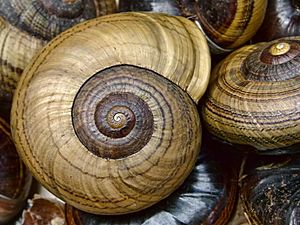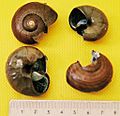Powelliphanta facts for kids
Quick facts for kids Powelliphanta |
|
|---|---|
 |
|
| Shell of Powelliphanta hochstetteri bicolor | |
| Scientific classification |
|
| Kingdom: | Animalia |
| Phylum: | Mollusca |
| Class: | Gastropoda |
| Subclass: | Heterobranchia |
| Clade: | Euthyneura |
| Order: | Panpulmonata |
| Clade: | Eupulmonata |
| Clade: | Stylommatophora |
| Family: | Rhytididae |
| Genus: | Powelliphanta O'Connor, 1945 |
| Species | |
|
See text. |
|
Powelliphanta are really big, air-breathing land snails found only in New Zealand. They are special because they eat other small creatures, mostly native earthworms. These snails often live in small areas of wet forests. Sadly, many Powelliphanta species are in danger because of animals brought to New Zealand by humans.
Contents
About Powelliphanta Snails
How They Got Their Name
The Powelliphanta snails were first described in 1945 by A. C. O'Connor. They were named after Mr. Arthur William Baden Powell, who helped a lot with studying these types of snails. At first, they were thought to be a smaller group within another snail family called Paryphanta.
Later, in 1977, scientists decided that Powelliphanta were different enough to be their own main group, or genus. Today, there are at least 21 different species and 51 subspecies of Powelliphanta snails.
Where They Live
Powelliphanta snails are endemic to New Zealand, meaning they are found nowhere else in the world. You can find them in the North Island from Lake Waikaremoana down to the Kapiti Coast. In the South Island, they live from the Marlborough Sounds all the way to Fiordland and Southland.
The most different kinds of Powelliphanta live in the mountains of northwest Nelson and north Westland. Some species live in very tiny areas. For example, Powelliphanta gilliesi brunnea is found in only about one hectare (the size of a rugby field) of coastal forest.
Their Home Environment
These snails mostly live in moist native forests. Some prefer forests in low-lying areas, like P. traversi traversi. This snail is highly endangered and has its own special 10-hectare reserve of forest and swamp near Levin.
Other species live in forests higher up in the mountains, or even under tussock grasses above the treeline. Many Powelliphanta species only live in forests where the soil is made of limestone. This is because they need calcium to build their shells and eggs. They get this calcium by eating other small creatures that have absorbed calcium from the limestone ground.
Powelliphanta snails need a very wet environment. Unlike some other land snails, they cannot seal off their shells with a protective slime layer to keep from drying out.
What They Look Like
The biggest Powelliphanta species, Powelliphanta superba prouseorum, can have a shell up to 9 cm (about 3.5 inches) wide. It can weigh as much as 90 grams (about the same as a small apple).
Their shells are very beautiful with delicate patterns. They come in many colors like brown, red, yellow, or black. The shells are quite fragile. They have a very thin layer of calcium carbonate (like chalk) covered by a thicker outer layer made of chitin (the same material insect shells are made of). These snails need moist surroundings. If it gets too dry, the outer layer of their shell can shrink and crack.
Life Cycle and Habits
What They Eat
Powelliphanta snails are carnivorous, which means they eat meat. They mostly eat earthworms or slugs. They are nocturnal, meaning they are active at night. During the day, they hide buried under fallen leaves and logs.
Powelliphanta use a special tongue-like belt of teeth called a radula to eat their prey. They don't swallow their prey whole. Instead, they scrape off pieces of flesh with their radula and pull it into their mouth.
Reproduction
Powelliphanta snails can live for 20 years or even longer. They grow slowly, becoming old enough to have babies around 5 to 6 years of age. They are hermaphrodites, which means each snail has both male and female reproductive parts.
They lay 5 to 10 large eggs each year. These eggs are about the size of a bean and have a thin, pink shell, like a tiny bird's egg. For snails living in lowlands, the eggs hatch in 2 to 6 months. For those living in high-altitude areas, it can take much longer, about 12 to 14 months, for the eggs to hatch.
Ancient History
Powelliphanta snails have a very long history. Their ancestors originated more than 235 million years ago on the supercontinent Gondwana. When New Zealand broke away from Australia about 80 million years ago, these snails became isolated. Over millions of years, they slowly changed and developed into the many different species we see today.
Conservation Status
Most Powelliphanta snails are in serious danger of disappearing forever. Their main natural enemy is the weka, a native New Zealand bird. However, they have no way to defend themselves against animals that humans brought to New Zealand. These include brushtail possums, pigs, hedgehogs, and rats. Possums, for example, have been known to eat up to 60 snails in just one night.
Changes to their forest homes and being trampled by introduced animals like goats, deer, and cows also threaten them.
Protecting these snails from introduced animals is now very important for their survival. The Department of Conservation is working on many plans to help them recover. For instance, after a special pest control operation using 1080 poison, the number of P. "Anatoki Range" snails in Kahurangi National Park grew three times larger. In one area, 54 snails were found before the poison, and a year later, 147 snails were found in the same spot.
The subspecies Powelliphanta gilliesi brunnea and Powelliphanta traversi otakia are the most threatened. It has been illegal to collect Powelliphanta shells since 1982. Collecting live snails for their shells made some species even rarer. However, some species actually need to eat discarded shells to get calcium for their own shells.
Species
Here are some of the species within the Powelliphanta group:
|
|
Cultural Relevance
A picture of a Powelliphanta snail, drawn by Dave Gunson, was featured on a New Zealand 40-cent postage stamp in October 1997.
Images for kids
-
Possum-preyed Powelliphanta traversi snail shells.







